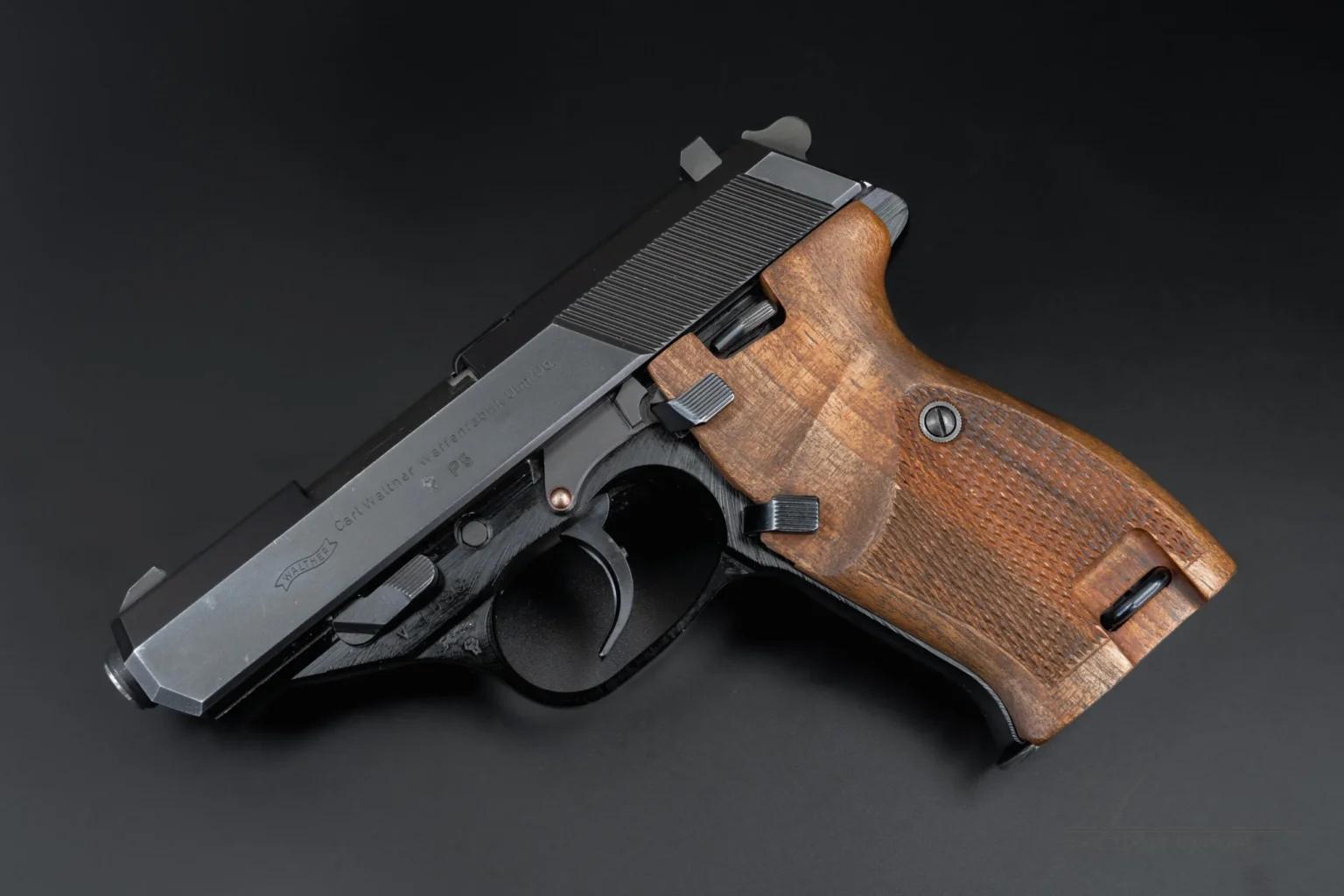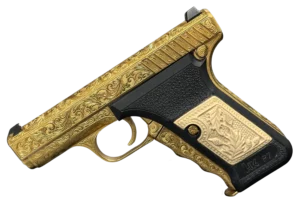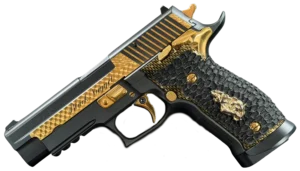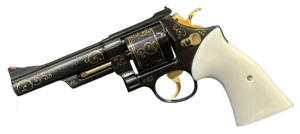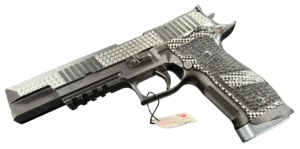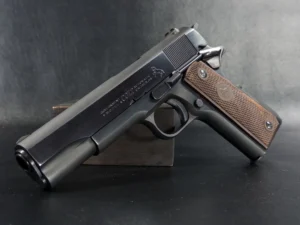Key Takeaways:
- The Walther P5 blends old-school craftsmanship with practical innovation: Born from the iconic P38 lineage, the P5 refined what worked and left behind what didn’t. With features like a fixed barrel for better accuracy, a frame-mounted decocker, and left-side ejection, it quietly redefined what a modern service pistol could be, without ever making a fuss about it.
- It’s more than a collector’s item—it’s still a capable, real-world firearm: Sure, the P5 has become a sought-after piece for collectors, but don’t let that fool you into thinking it’s just for display. Its reliability, safe handling features, and intuitive ergonomics make it perfectly viable for concealed carry or home defense, especially if you value quality over capacity.
- The P5’s lasting appeal lies in its thoughtful simplicity: in a market full of bells, whistles, and tactical gimmicks, the Walther P5 stands apart by focusing on what truly matters —safety, balance, and precision. It doesn’t try to impress with flash—it earns respect with every trigger pull and every decade it continues to run flawlessly.
There’s something about the Walther P5 that feels… different. It’s not just another 9mm semi-auto; it’s a thoughtful expression of German engineering precision, molded into a sleek, reliable sidearm. If you’ve ever handled one, you already know—it doesn’t just fire; it feels like it was built to outlive everything else in your safe.
Whether you’re a seasoned collector, someone shopping around for a dependable carry piece, or just a fan of elegant Cold War-era pistols, the Walther P5 deserves a closer look. It may not scream for attention, but it earns your respect with every pull of the trigger.
Let’s walk through what makes the P5 so admired, even decades after its debut.
More Than Metal: The Legacy of the P5
Here’s the thing—Walther didn’t build the P5 to show off. They built it to address a specific issue.
By the mid-1970s, European police forces were seeking a modern, reliable 9mm service pistol to replace their aging World War II-era sidearms. Walther had already proven their chops with the P38 and the P1, but the world had changed. The demands were higher. So, in 1977, Walther introduced the P5—not as a radical reinvention, but as a thoughtful evolution.
What emerged from that effort was a compact, safe, and precise firearm that quietly shaped expectations for decades. The P5 was never mass-produced on the scale of Glock or Beretta. But its design? That influence ran deep.
Built on a Strong Foundation: The P5’s Evolution
Let’s rewind a bit.
The P5 didn’t come from thin air—it grew out of the DNA of the iconic Walther P38. That pistol, first fielded in WWII, was revolutionary in its own right. But as the world moved forward, the P38’s quirks began to show. Walther took the best elements of that gun—the locking block system, the overall balance—and trimmed the fat.
The result? A sleeker, more modern pistol that retained the P38’s ruggedness while adding thoughtful improvements.
One of the most curious updates was the P5’s left-side ejection port. Yep, you read that right. While most pistols fling spent casings to the right, the P5 kicks them out to the left—ideal for left-handed shooters and a head-scratcher for everyone else the first time they see it. But it works.
Another innovation? The decocking mechanism. More on that in a minute, but let’s say it was built with safety in mind—and executed with classic German logic.
Specs That Make Sense
Let’s get the technical stuff out of the way—but not too dry, I promise.
Here’s what you’re working with:
- Caliber: 9mm Parabellum
- Barrel Length: 3.5 inches
- Overall Length: 7.1 inches
- Weight: About 28 ounces (unloaded)
- Magazine Capacity: 8 rounds
- Ejection Direction: Left-side
Those numbers paint a picture of balance. The P5 is compact without feeling tiny. It’s solid in the hand, but not heavy. You could carry it all day—or let it sit on your nightstand—without feeling under-armed.
And yes, eight rounds might feel conservative compared to today’s double-stack polymer pistols. But let’s be honest—most people aren’t engaging in drawn-out gunfights. For personal defense or duty use, 8 rounds of 9mm—especially when you can reload fast—is more than enough.
Design That Feels Right
Have you ever picked up a tool and… get it? That’s the P5.
The grip isn’t flashy. It doesn’t have interchangeable backstraps or stippling that could sand paint off drywall. But it fits the hand. The contour of the grip, the angle, the natural point of aim—it all feels intuitive.
Even the slide is worth a second look. It rides inside the frame, not over it like most pistols. This keeps the profile low, helps manage recoil, and gives the P5 a signature sleek look. It’s like a Porsche door—clean, precise, and not trying too hard.
Controls are simple. You’ve got a slide stop, mag release, and that clever decocker mounted on the left side of the frame. Press it down, and the hammer lowers safely. No awkward manipulation, no accidental discharges. Just deliberate, secure operation.
It’s not a “tactical” pistol in the way modern polymer pistols are marketed. But it’s engineered to do one job: shoot well, shoot safely, and shoot consistently.
What Makes the P5 Stand Out?
It’s easy to overlook the P5, as it lacks rails, optics-ready options, and a trigger safety tab. But that’s not the point.
What sets it apart are a few subtle features:
- Slide inside the frame – Reduces play and improves accuracy.
- Left-side ejection – Great for left-handed shooters and quirky enough to start conversations.
- Fixed barrel – Yep, the barrel doesn’t tilt. It stays put, which improves accuracy shot after shot.
- DA/SA trigger – Long, deliberate first pull (double-action), then light, crisp follow-ups (single-action).
The whole package works. It’s reliable. It shoots flat. It points naturally. And you don’t need a college course to field strip it.
It’s the kind of gun you come to appreciate more the longer you own it.
Real-World Reliability: Law Enforcement & Military
What sells a gun’s quality? When cops and soldiers bet their lives on it.
The Walther P5 was adopted by Dutch law enforcement in the late ’70s, becoming their standard-issue sidearm. It was rugged enough to survive harsh duty conditions, yet refined enough to maintain mechanical precision under stress.
Back home in Germany, multiple police units also ran the P5. It performed admirably in real-world conditions—urban patrols, high-stress incidents, and training environments. It was dependable, and more importantly, intuitive. Officers trusted it.
Even select military and counter-terror units gave the P5 a go. Why? Because it worked. Every time. Rain, mud, cold, dust—you name it.
Is It a Good Choice for Concealed Carry?
This is where things get interesting. The Walther P5 wasn’t built with civilian concealed carry in mind, but it turns out to be quite good at it.
Its slim profile and modest weight make it easy to carry, even with a decent holster. The decocker makes it safe to take with a chambered round. And the trigger system offers both control and flexibility.
Now, is it the tiniest, lightest 9mm out there? No. But it’s no brick either. If you’re looking for something classic, durable, and easy to shoot under stress, the P5 checks a lot of boxes.
And for those who want something even smaller?
The Walther P5 Compact: Same DNA, Smaller Package
Enter the P5 Compact.
It takes everything people love about the original P5 and trims it down just enough. Shorter barrel, shorter grip, slightly reduced weight—but all the same features and mechanical integrity.
If you’ve smaller hands or prefer a more discreet option, the Compact is a great choice. Accuracy remains on par, thanks to the fixed barrel and crisp trigger.
Honestly, it’s one of the most refined “compact” pistols ever made, without falling into the micro-pistol trap of being too small to shoot comfortably.
Easy to Maintain, Simple to Love
You don’t need a degree in mechanical engineering to keep the P5 in top shape. Disassembly is intuitive, and cleaning is quick, especially with modern lubricants and tools.
And here’s the good news: parts are still available. You’ll find springs, magazines, and even replacement grips if you poke around the collector and surplus markets. Walther didn’t produce the P5 in massive numbers, but they built them to last.
And while it’s not the most “modular” pistol out there, a few aftermarket options exist, especially for those looking to change grips or tweak trigger pull.
A Star in Popular Culture
Quick sidebar—ever seen Sean Connery as James Bond in Never Say Never Again? Look closely. That’s not the famous Walther PPK in his hand—it’s the P5.
Why the change? Some say it was just an update for the ‘80s. Others suggest it was chosen to reflect Bond’s evolution. Either way, it was a stylish nod to modernity—and gave the P5 a bit of Hollywood stardust.
Since then, it has appeared sporadically in European films and TV. It’s not overexposed, which makes it even cooler.
A Collector’s Gem with Lasting Value
Collectors are a funny bunch—we chase condition, provenance, and rarity. The P5 checks all three boxes.
Because production numbers were relatively low—especially for the Compact variant—well-kept models are in demand. And if you’ve got one in its original box, with factory papers and magazines? You’re sitting on a gem.
Prices have remained steady, and interest continues to rise as people rediscover the P5’s place in firearm history. It’s not just a shooter; it’s a statement piece.
So, Where Does the P5 Stand Today?
In a world flooded with polymer-framed, optics-ready pistols, the Walther P5 is a refreshing throwback.
It’s not tactical. It’s not modular. It won’t take a red dot or a weapon light. But you know what? That’s part of the charm. It was designed for photographers. People who appreciate craftsmanship. People who want their sidearm to last decades, not just until the next trade-in.
Final Thoughts: An Unassuming Masterpiece
The Walther P5 may not shout for your attention, but once it has it, you’ll find yourself coming back to it over and over.
It’s a gun built on thoughtful evolution, not trends. It values safety without sacrificing speed. And while it’s no longer in production, it still manages to feel surprisingly modern.
So, whether you’re collecting, carrying, or just admiring the subtle brilliance of German design, the P5 is one of those pistols that deserves a permanent place in your collection—and your story.
Looking to purchase a Walther or a Walther P5? Check out our store pages. Shop Walther or Shop Walther P5.
Frequently Asked Questions
One word? Refinement. The P5 took the proven mechanics of the Walther P38 and smoothed the edges—literally and figuratively. It features a fixed barrel, a decocker mounted directly to the frame, and a unique left-side ejection system that sets it apart from just about every other service pistol of the era. It wasn’t made to be flashy—it was made to work, and it does that exceptionally well.
Surprisingly, yes. While it was never marketed as a “carry gun” by modern standards, its slim profile, 3.5-inch barrel, and manageable weight make it a viable option for concealed carry. It’s not as light as today’s polymer wonders, and you’re limited to 8 rounds, but for those who prefer classic steel and outstanding ergonomics, it carries like a dream.
Classic double-action/single-action. That means the first pull is longer and heavier—intentional, for safety—followed by light, crisp single-action breaks. It’s not a match trigger, but it’s clean, predictable, and gives you absolute control once you get used to it.
Absolutely. Left-handed shooters typically have to adapt to right-ejecting pistols and catch hot brass on their arms as a bonus. The P5 flips that script by tossing casings out the left, making it far more ambidextrous without needing extra hardware or modifications. For lefties, it’s one of the few factory pistols that feels like it was made with them in mind.
To a degree, yes. While Walther discontinued the model, parts—especially magazines, springs, and grips—can still be found through specialty retailers, surplus channels, or collector communities. It’s not as easy as grabbing Glock parts off the shelf, but if you’re a little resourceful, the P5 is maintainable.


